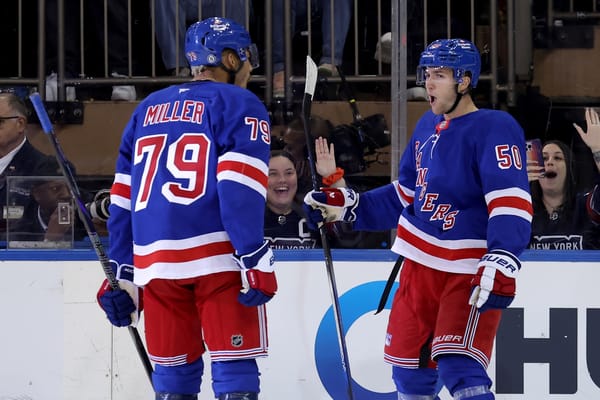A Look at Visors, Player Safety, and the Battle Between Logic and Tradition
Where do we draw the line between logical, reasonable precautions for player safety and the value of tradition and personal choice?
One of the most inspiring and amazing things I've ever seen in a hockey game happened in Game Six of the 2003 Stanley Cup Finals after Paul Kariya was knocked unconscious after a six-foot wrecking ball on skates named Scott Stevens blindsided him with a merciless body check. Call the play dirty (Kariya was hit well after dishing off the puck), call it playoff hockey, call it whatever you want. All that really matters is what happens after Paul Kariya is lying on his back, on the ice, more or less motionless.
After what feels like an eternity Paul Kariya's visor suddenly fogs up and his eyes snap open. Everyone in the stands breathes a sigh of relief and applaud their captain getting back to his feet while his teammates look on in concern from the bench as he is helped off the ice. Paul Kariya, against the advice of medical professionals, returned to the game in the very same period he was knocked unconscious in and played like a man-possessed, eventually scoring a crucial goal in a must-win game for his team. After he scores Gary Thorne enthusiastically barks, "Off the floor, on the board Paul Kariya!"
It is, without a doubt, one of the most incredible things I have ever seen in sports.
And we'll never, ever see it again because of the NHL's new concussion policy, and that is just the way it should be.
I really and truly love hockey. I love hockey on irrational levels, it impacts my day to day life much more than it should. But for all my love of hockey there are aspects of it that depress and disappoint me. Among them are the countless serious injuries that could be avoided if players respected each other more and did more to protect themselves from preventable injuries. When tradition and personal choice become obstacles on the logical path to a safer game I can't help but begin to question the value of tradition and personal choice.
We all know what happened to Marc Staal on March 5th in a game against the Philadelphia Flyers. Although there has been speculation about whether or not a visor would have done much of anything to prevent his eye injury (there was even some speculation by an anonymous equipment manager that a visor would have made the injury worse) there is no escaping the fact that visors prevent more injuries than they cause. The debate about visors has been heating up lately, especially due to recent injuries suffered by Manny Malhotra of the Canucks and the Rangers' own Marc Staal. In an article by Pat Leonard of the New York Daily News Martin Biron had this to say of visors being made mandatory:
"We'll probably get a general sense to where players are over the summer... Certain years the issue comes up more than others, but a lot of times we break into smaller groups where people can share their ideas on different issues. It sometimes makes for better discussions and then we can bring it back to the whole group."
"I'm a goalie, but you hear about how visors can affect your sight or your breathing," Biron said. "I don't know, but it's common sense to me for it to become a more concrete issue than it is now. I bet back in the day players disagreed on wearing helmets, but the game grew and as we went on helmets became mandatory. But there are players who wear visors who still think players should have the choice. So that's why these discussions are important."
Still, visors cannot and probably will not prevent all face and eye-related injuries. However, there is another option that would prevent even more injuries than visors that no one seems willing to talk about. Face shields.
Players, both amateur and professional, will complain that face shields (and visors) obscure vision (as Marty Biron mentioned in the quotes above). I know from experience that they certainly are capable of doing that. There is also a point to be made about brief moments of obscured vision in the middle of a professional hockey game being immensely dangerous for skaters wearing face shields. I'd be willing to listen more to that point if not for the fact there are metal face shields with visors built into them and completely clear face shields that are currently used in NCAA hockey. Goalies, who need unobstructed vision more than any other player on the ice, wear face shields because at some point everyone realized it was crazy for them to not be wearing them, even at the expense of sometimes having their vision slightly obscured. So why is it any different for forwards and defensemen?
Would hockey be any less fast, entertaining, or exciting if everyone on the ice was wearing a visor or a face shield? Would body checks be any less thunderous? Would pretty plays be any less pretty? Of course, face shields and visors being omnipresent would likely spell the end of fighting but in my opinion that is a completely separate issue. How important is personal choice and tradition compared to players losing their vision or possibly their eyes? I'm waiting for a reasonable counterpoint that sways me and makes me think that, at the very least, visors shouldn't be made mandatory. I'm not quite sure I've heard one that is convincing yet.
I understand the importance of personal choice and being entitled to make a decision about your own safety. It's your face. You should get to choose whether or not you wear a visor or a face shield. It is hard to argue against that point without running to hyperbolic analogy so forgive me for doing so.
After a certain point, a "certain point" in this case meaning enough deaths and gruesome injuries to make some kind of action necessary, wearing seatbelts in automobiles became mandatory. Someone made the call that people needed to be protected from their own bad choices because enough people couldn't make the call that logic demanded they make on their own. Many professional athletes operate under the assumption that they are nearly indestructible, especially in their youth. We can hardly blame them- they look like they're cut from marble, they perform and excel under pressure, and they have earned a place in a major sports through a combination of god-given talent and hard work. But they are human beings capable of making mistakes and bad calls regarding their own health and safety. We need only look at Paul Kariya stepping back onto the ice in Game Six of the 2003 Stanley Cup Finals and later having his career cut short due to accruing too many concussions to see that players don't always make the best decisions for their own health and safety. Adrenaline, perhaps excessive levels of confidence, external pressure, and a feeling of near-invulnerability are a bad combination for making educated decisions about returning to play after suffering an injury. They are also not the best recipe for ensuring that players take the proper precautions to ensure their own safety.
Ultimately the decision is in the hands of the NHLPA and the players and that is just how it should be. Thankfully the NHL and the NHLPA are taking player safety a great deal more seriously than they were just a decade ago. Still, it seems like the process is moving too slowly. Whether it is Erik Karlsson not wearing Kevlar socks, Marc Staal not wearing a visor, or countless other examples it seems to take a serious injury before preventable injuries are taken seriously and discussions begin about whether or not steps have to be taken to protect players more than they seem to want to protect themselves.
I don't pretend to have all the answers regarding player safety and I don't pretend to think I have the right to demand that athletes wear Kevlar socks and start wearing visors or face shields. These are decisions that the players are going to have make for themselves and discuss during the summer at NHLPA meetings. I, for one, hope that we start to see more steps toward preventing reasons through reasonable measures and that player's lives and well being recognized as more important than personal choice and tradition.
I am curious to hear what you guys have to say about this, so let's turn it over to you for discussion in the comments section.
Would you stop watching hockey if visors and/or face shields were made mandatory? Where do we draw the line between personal choice and safety in sports?
I have a lot more to say about this subject and subjects similar to this one, if you guys want to see and read more please let me know. Thanks. Let's go Rangers.




